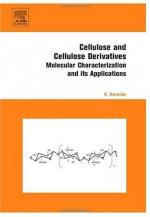|
This section contains 494 words (approx. 2 pages at 300 words per page) |

|
Cellulose, the major component of cell walls in plants, strengthens roots, leaves, and stems, making them rigid. It is a polysaccharide, a long molecule composed of oxygen, hydrogen, and sugar, and is very similar to the structures of sugars and starches. The hydroxide groups in cellulose are isotactic--that is, they are on alternating sides of the main chain. These pendant groups bind with others on long cellulose molecules to form microfibrils. French chemist Henri Braconnet (1780-1855), a leading figure in the field of animal and plant chemistry, verified the existence of cellulose in 1819, discovering the component in mushrooms and calling it fungine. He then began experimenting with the effects of sulfuric acid on wood. Braconnet eventually succeeded in creating a nitrated cellulose, which he called xyloidine, by adding wood or potato starch to nitric acid.
In 1834, Anselme Payen, another French chemist, succeeded in isolating cellulose from wood. He...
|
This section contains 494 words (approx. 2 pages at 300 words per page) |

|


